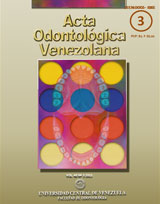EFICACIA DEL PROCESO ADHESIVO EN DENTINA ESCLERÓTICA - REVISIÓN DE LITERATURA
Palabras clave:
Dentina, dentina esclerótica, adhesivos dentinariosResumen
La propuesta de esta revisión sistematizada fue evaluar cuál sistema adhesivo y cuál técnica son los más indicados para ser usados en lesiones cervicales no cariosas con dentina esclerótica. La búsqueda de los estudios fue realizada en las bases de datos electrónicas PubMed, Embase y Bireme/Medline, incluyendo estudios entre los años 1990 y 2009. Los criterios de inclusión fueron: ensayos clínicos randomizados utilizando dentina esclerótica tratada con diferentes tipos de sistemas e técnicas adhesivas, estudios randomizados in-vitro con respecto a resistencia adhesiva a la microtracción, gaps de contracción, y evaluación de la interface adhesiva utilizando microscopia electrónica de barrido o transmisión. Desde 1807 artículos identificados, trece estudios cumplieron los criterios de inclusión, los cuales describieron alta complejidad estructural de la dentina esclerótica, con alto contenido mineral y cast escleróticos que obstruían la entrada de los túbulos dentinarios, reduciendo la permeabilidad dentinária y alterando sus propiedades adhesivas. La capa hibrida formada fue reducida sin tags resinosos, siendo que la aplicación de acondicionadores ácidos en altas concentraciones o en periodos prolongados de tiempo, así como la remoción de la capa superficial de dentina esclerótica, fueron ineficientes para incrementar la resistencia adhesiva. Los resultados también sugieren que la utilización de sistemas adhesivos auto-acondicionantes en dentina esclerótica debe ser evitada.
ABSTRACT
The purpose of this review was to evaluate witch adhesive system and technique are the most suitable to be used at non carious cervical lesions with sclerotic dentine. The search was carried out in the electronic databases PubMed, Embase and Bireme/Medline, including studies published from 1990 to 2009. The inclusion criteria were: randomized clinical trials with sclerotic dentine treated with different types of adhesive systems and adhesive techniques, randomized in-vitro studies concerning to microtensile bond strength, contraction gap and dentine/adhesive interface evaluation. In total, 1807 papers were identified and only thirteen studies met the inclusion criteria, which showed high complex structure of sclerotic dentine, with high mineral content and sclerotic casts that obstruct the entrance of dentine tubules, reducing the dentin permeability and altering their adhesive properties. The hybrid layer formed at sclerotic dentin is smaller than at sound dentin and without resin tags and the use of high concentration of acids conditioners for longer periods or the remove of the superficial hipermineralyzed layer showed to be inefficient to increase the bond strength. It is also suggest that the use of self-etching adhesive systems has to be avoided at sclerotic dentine.

